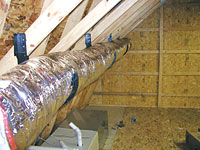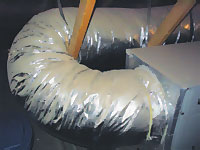As with any great product, however, the key to its optimum performance is proper installation. Too often, flex ducts are not installed properly, and they end up kinked, bunched up, undersized, or sagging.
These issues can cause increased resistance in the duct system, resulting in too little airflow reaching a building's heating and cooling equipment. Too little airflow reduces the system's capacity and efficiency and means that some rooms may not get enough warm or cool air, leaving occupants feeling uncomfortable.
There are many resources available that show contractors how to properly install flex duct. Manufacturers have their guidelines, and the Air Diffusion Council (www.flexibleduct.org) publishes a manual titled Flexible Duct Performance and Installation Standards, which is commonly referred to as the "Green Book." The manual shows exactly how flexible ducts should be installed. Reading the instructions isn't everyone's strong suit, but in this case, it should be mandatory for all installers, as it is the only way to ensure the end user's heating and cooling equipment will perform as promised.

Why There Are Problems
With the prevalence of flexible duct in the HVAC world, it would seem that everyone would know how to install it properly. So why are there so many problems with improperly installed flex duct?"It's a combination of things," said Rick Young, vice president of sales and marketing, QuietFlex, Houston (www.quietflex.com). "I think people look to shave costs, and they're pushed for time, so they rush through a job instead of taking the time to do a good job. And people are not taking the time to get properly trained on installation procedures. They need to study the installation guidelines in the Green Book and make sure they know them well and follow them."
Young noted that one of the most common errors contractors make regarding flex duct is installing ducts that are too small. "Contractors often put in 6-inch duct, when ACCA's Manual J might call for 8-inch duct. Another problem is that ducts are not always properly joined together, which results in leakage. Only tape that meets UL181 standards should be used, but some contractors still use duct tape, and they shouldn't."

When the decision is made to use flex duct on a job, Hoag recommends that contractors keep the following tips in mind:
There are also products available that are intended to make flex duct installation easier, so that there aren't as many problems. One of those products is the Paramount Jâ„¢ duct hanging system.
In a typical application, installers must wrap strap around the flex duct, cut the strap to the appropriate length, nail or staple the strap to the joists, and then repeat this process along the entire length of the flex duct. Using the Paramount J system, installers can preinstall the hangers on joists, then simply place the flex duct into each hanger.
The manufacturer states that using the Paramount J also reduces the problems associated with airflow. "Support straps typically fold over on the sides and can slide in between the support wires inside the flex duct," stated Michael Pratt, president, Paramount Concepts, Springboro, Ohio (www.paramountconceptsltd.com).
"This leads to crimps, and once the structural integrity of the flex duct is changed, airflow is compromised. The saddle portion of the Paramount J hanger is designed to provide solid support to the flex duct, eliminating crimps and preserving airflow."

What Can Happen
While improperly installed flex duct can have the short-term result of not providing enough heating and cooling to a space, there are long-term problems to watch out for as well. According to Jack Bartell, manager - training services, York International, Norman, Okla. (www.yorkupg.com), when an air conditioner (or heat pump in cooling mode) operates at less than expected airflow across the evaporator, it will result in a lower coil temperature."This, in turn, leads to frost on the coil, which causes more restriction to the flow of air and leads to more frost," stated Bartell. "This snowball of cause and effect leads to a loss of capacity, so the thermostat cannot satisfy the demand for cooling. This results in a long-run cycle with little or no effect on comfort, along with an enormous waste of energy."
The most serious result of low airflow in cooling mode is how it affects the compressor. Low airflow means less heat is delivered to boil off the refrigerant flowing through the evaporator, resulting in liquid refrigerant getting to the compressor. This dramatically reduces the life of the compressor and is considered the major cause of compressor failure.

Furnaces can also experience problems when flex duct is installed improperly. "If many of the heat runs are kinked or crushed, it could possibly cause the furnace to overheat and cut out on limit. Over time, the furnace could suffer cracks to the heat exchanger," stated Hoag.
It's best to install flex duct properly right from the get-go, because once the drywall is up, it can be very difficult to repair problems. "A tear in the flex duct that may have been overlooked by the installer, builder, or inspector can be nearly impossible to fix or find," Hoag pointed out. Houses in which very long duct runs have been installed may also be difficult to fix, as access to the further reaches of the flex duct may be impossible.
There's really no reason why flex duct should ever be installed improperly, as the resources are there for everyone to learn proper installation techniques. If care is taken on every job, the flex duct system should operate well for many years, resulting in fewer callbacks and happier customers.
Publication date: 07/25/2005


Report Abusive Comment